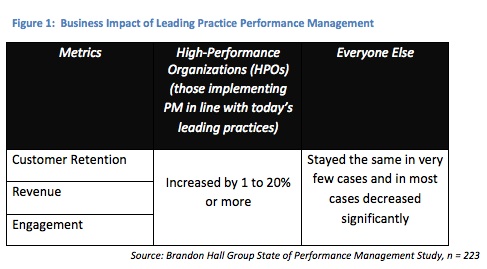
Performance management (PM) has been a business practice for more than 50 years. The business imperative for performance management is undeniable, yet organizations everywhere seem disenchanted with the effectiveness of their approach to performance management. In Brandon Hall Group’s recent research report, Performance Management 2015: Coaching for Development Needed, the majority of organizations reported that improving overall business performance is a critical outcome of their performance management. Some 88 percent have a performance management strategy, but 71 percent say their current approach to performance management needs improvement, even reinvention.
Even though there is a lot of talk about fresh performance management practices, our study revealed that few organizations have made any significant enhancements to the traditional “rank-and-stack” approach.
The top findings of the State of Performance Management Study, completed by 223 global survey respondents are:
- Performance management strategies are prevalent, but largely ineffective.
- There is too little focus on the employee, and too much focus on the performance management process.
- There is a significant lack of executive engagement in performance management.
- In-the-moment feedback—as opposed to formal reviews—improves performance.
- Few managers are skilled development coaches.
- Executives and senior leaders get more performance planning attention than individual contributors and hourly workers.
- The future of performance management promises more strengths-based development and in-the-moment feedback.
- Strong performance management yields better business results.
8 Leading Practices
The survey and additional interviews and conversations with high-performing organizations with sophisticated performance management programs revealed eight leading practices for managing performance. They are:
- Create the PM strategy in alignment with the business strategy, ensuring cascaded goals.
- Institutionalize PM as an ongoing process—not an annual event with a beginning and an end.
- Focus on developing employees’ strengths, not evaluating their weaknesses, and eliminate the forced distribution system.
- Engage peers and subordinates in providing performance feedback.
- Review and revise employees’ goals regularly to ensure alignment with changing business priorities.
- Catch employees performing well (or not so well) and provide immediate, on-the-fly feedback, and do so regularly.
- Define and execute on targeted individual development plans (IDPs) enabled with performance support tools.
- Define a select few metrics to measure the business impact of performance management and monitor those metrics regularly for continuous improvement and to create a culture of high-performance.
5 Calls to Action
So you might be asking what real business difference do high-performing organizations experience by adoption and execution of these practices? The answer is simple, and downright compelling: better business results.

If you like what you see regarding business impact, commence the transformation today of your traditional performance management practices. Expect the transformation to be a journey, but like breaking any bad habit, getting started is the key to success. In talking with CEOs, other business leaders, and HR and talent leaders at high-performing organizations, these organizations fast-tracked the makeover by prioritizing five calls to action:
- Teach managers to be effective development coaches.
- Eliminate forced distributions
- Engage executives in performance management
- Hold leaders responsible for developing employees’ strengths.
- Automate performance management and integrate it with other talent processes.
Leading Practice Performance Management
Our research results exposed high-performance PM as a continuous cycle of phases.
Phase 1: Define the Strategy
In this phase, the PM strategy is defined. The strategy is guided by the organization’s philosophy of performance management. Answers to the following questions reflect an organization’s commitment to a PM strategy and its philosophical points of view:
- Do we have a formal performance management strategy in place?
- What are the outcomes (desired and actual) of performance management?
- Are executives and other business leaders engaged in the process?
- Do we clearly communicate our performance management philosophy and expectations to all employees?
- Do we have written performance goal plans for all employees?
- Do we hold leaders accountable for performance?
- Are we focused on development of employees’ strengths (versus evaluation of their weaknesses)?
- Will we eliminate the “rate-and-rank” approach (versus force fitting all employees into the standard bell curve with the intent to dismiss those who fall into the bottom 10 percent)?
- Will our managers have continuous and ongoing discussions with employees about their performance (versus one-time annual performance appraisal discussions)?
- Will we separate performance and compensation discussions (versus having both at the same time)?
- Will we require feedback from an employee’s manager and peers and subordinates (versus only top-down feedback)?
- Do we expect our managers to identify and reward exemplary performance?
Phase 2: Set Employee Goals
In this phase, managers and employees work together to set clear employee goals that accelerate achievement of the organization’s business goals. Answers to the following questions reflect an organization’s efficiency and effectiveness in goal setting:
- Are employee goals cascaded?
- Are employee goals regularly reviewed and revised (to stay in alignment with changing business goals)?
- Are goals SMART—Specific, Measurable, Achievable, Realistic, Timely?
- How many of our employees have written performance goals?
Phase 3: Coach Employees for Skill Growth
In this phase, the organization, its managers, and employees collaborate to develop employees’ strengths. Answers to the following questions reflect an organization’s commitment to ensuring their managers have the skills, tools, and resources to act as development coaches:
- Do we provide “manager as coach” training?
- Are our managers skilled in development coaching?
- Do our managers clearly communicate performance expectations?
- Do we make it a practice to solicit peer and subordinate feedback (not just managerial feedback)?
- How frequently do our managers provide performance feedback?
Phase 4: Develop Employees’ Strengths
In this phase, managers and employees work closely together to plan for and execute on strengths-based development plans for each employee. Answers to the following questions reflect an organization’s capability to offer strengths-based development:
- Are managers skilled at defining actionable and targeted development plans for each employee?
- Are managers effective in having regular career management conversations with employees?
- Are managers effective in formal strengths-based development coaching?
- Do we provide our employees with performance support via technology and online tools?
Phase 5: Optimize Performance Continuously
In this phase, organizations leverage performance data to monitor current, and predict future, performance for purposes of embedding an accountable and high-performance culture. Answers to the following questions indicate an organization’s ongoing ability to proactively mitigate performance risk in critical talent segments and key job roles:
- Does our approach to PM support achievement of our business goals?
- Does our approach enable our employees’ work to be efficient, effective, and aligned with our business goals?
- Can we count on our PM to be a business differentiator?
- Does the majority of our employees meet or exceed their performance goals on a regular basis?
- Do we achieve our annual business goals?
- Has our voluntary turnover rate decreased in the last 12 months?
- Has our revenue increased in the last 12 months?
- Have our customer satisfaction ratings increased in the last 12 months?
- Has our customer retention rate increased in the last 12 months?
- Has our engagement score increased in the last 12 months?
For the full results of the Brandon Hall Group Performance Management research, click here.
Laci Loew is vice president and principal analyst for the Talent Management Practice at Brandon Hall Group, a Human Capital Management (HCM) research and advisory services firm that provides insights around key performance areas, including Learning and Development, Talent Management, Leadership Development, Talent Acquisition and HR/Workforce Management.




